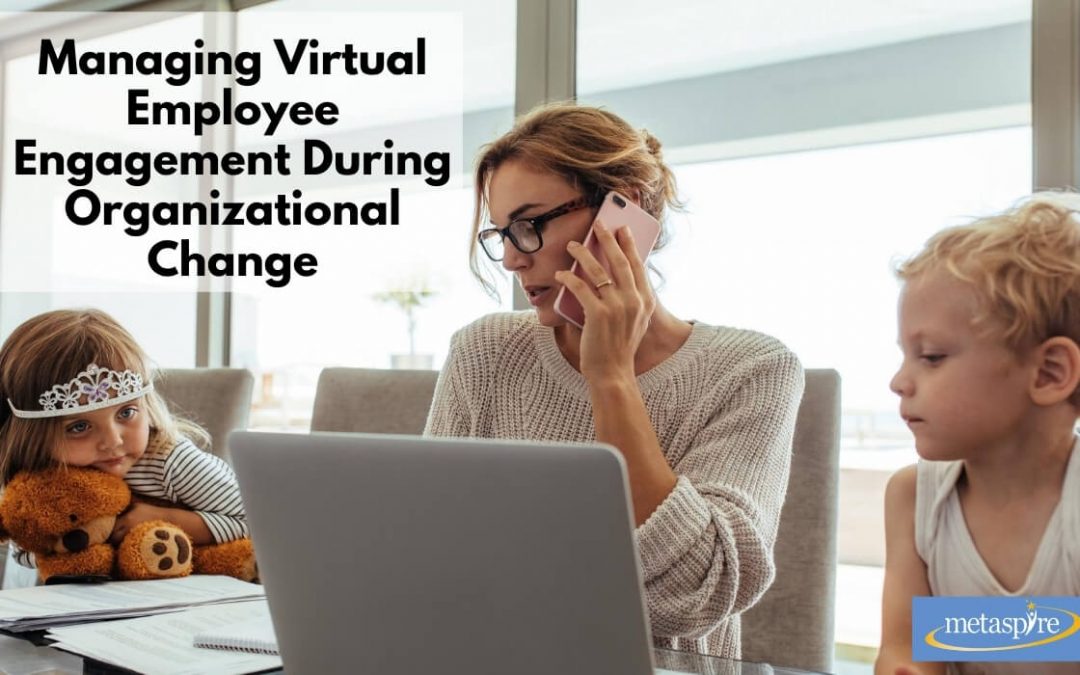Managing Virtual Employee Engagement During Organizational Change
What if I told you that you can successfully navigate the virtual team experience by practicing a modern leadership style approach with your team?
I recently conducted virtual interviews with leaders from some of the best places to work and they all agree that a modern leadership style is paramount to employee engagement especially during times of organizational change.
This style of leadership also builds trust between management and remote workers, which helps leaders retain their best employees, while also managing their own change curve.
Video conferencing has been around for quite some time, but we have never relied on it as heavily as we do today. Due to the present circumstances, Video conferencing has taken the place of many in-person events and we no longer meet face-to-face as frequently. Based on what is transpiring, it is expected that there will be even more opportunities to work remotely than ever before, increasing the requirement for virtual teams and effective virtual team leadership.
The modern leadership style approach includes these skills:
- Empathy.
- Patience.
- Effective Communication.
You may recognize these as part of the feminine leadership qualities that I outlined in my article The Real Truth About Feminine Leadership that are traditionally and stereotypically associated with women. When these are traits are nurtured in both male and female leaders as part of their modern leadership style it produces great results in the teams they lead.
Let’s look at each one in more detail.
Empathy
Remote team members working out of their homes experience different stress levels than that of office employees and are subject to both internal and external stimuli that are different than what they experienced in an office environment.
As Michael Peachy, the Vice President of User Experience at Ringcentral puts it, “Once the guardrails were off and we weren’t meeting typical business hours in the office, we noticed people working harder and have been getting stressed out. They lost the commute time that allowed them to decompress. Instead, they are getting up and sitting at their laptop with a bowl of cereal and then working straight through lunch.”
This is something to be mindful of when you are faced with navigating a virtual team environment. Phil Haynes, Head of Global Talent Acquisition at Zoom Communications, states, “You have a lot of people who don’t know how to work from home, and now they’re being forced to work at home, and they don’t know how to draw those boundaries.”
Additional modern leadership skills such as being supportive and having empathy come into play frequently and apply to cross-cultural members from different time zones working from their homes as well, since they also face the time-gap that may be intrusive to their “normal” workday.
And let’s not forget practicing self-empathy. I have never been through a pandemic before and certainly have not led a virtual team through one up until now. So, let’s start by being kind to ourselves.
As Amy Haworth, Chief of Staff at Citrix explains, “I think sometimes, especially as a leader, the focus ends up being my people first, myself second and it’s just natural because that’s sort of instinct when we are leading with empathy. It is usually we care about those who are around us versus what is happening inside. But that is a short-term fix, and it’s not sustainable.”

Patience
Have you ever been in a remote meeting that is interrupted by a technical glitch or by a disruption in an employee’s home environment (i.e. children or pets)? Ensure everyone is prepared for this inevitability and shows the leadership skill of patience when the time comes.
It is also important to establish rules and procedures with team members regarding patience. Phil Haynes, the Head of Global Talent Acquisition at Zoom, also states, “I don’t create an environment where my team feels like if they get a message from me, they’ve got to answer it right away, especially if they’re on vacation.”
Effective Communication
For successful team building, strong communication skills are needed to work cohesively with remote workers. Bill Cherry, a Practice Leader at Azidio, explains, “I think the key is transparency in terms of expectations. I tell them, I know you’re a good employee and I trust you to do your job. If you need anything I am right here.”
 Effective communication also includes active listening (repeating what you heard to check for understanding), and if you are leading large scale communication efforts, ensuring there are 2-way feedback loops in place to adjust strategy based on cultural readiness.
Effective communication also includes active listening (repeating what you heard to check for understanding), and if you are leading large scale communication efforts, ensuring there are 2-way feedback loops in place to adjust strategy based on cultural readiness.
As Rebecca Pai, Chief of Staff at American Express, expressed, “Communication is the key to have an open dialogue, we must communicate openly and honestly to explain to people the reasons behind any change.”
To manage a virtual team effectively, the best leaders build a level of trust through open, honest, and direct dialogue in the virtual environment.
Charlie DeMarco, an AppDynamics Director of Channel Sales Engineering, states, “Treating people like they want to be treated and having a real keen ear to listen, and be listened to, is important to how you can make things better together. I’ll spend 10 hours on video calls, trying to help people see that I am vying for their success. I show up and am present with them, so they know I am there to help them succeed.”
Effective communication is necessary for team management, especially when many employees are working from home.
What about managing change?
All of these modern leadership skills will help you engage your employees during organizational change.
A team, virtual or otherwise, requires open, honest and effective communication for the reasons behind the change. As a leader, you can also encourage employee engagement by demonstrating patience and allowing team members to become comfortable with the change, and the reasons why the change is occurring. You then display empathy by providing them the opportunity to ask questions once they have been given time to absorb the new information and acknowledge any concerns they may have.
Managing remote workers requires leaders to ensure that the employees are receiving timely and effective communication regarding the expectations concerning all of their roles. This establishes a shared vision with everyone involved toward a successful outcome.
 By displaying empathy and patience, while engaging in effective communication with remote workers, leaders support the transition to work-at-home to be less stressful for virtual teams.
By displaying empathy and patience, while engaging in effective communication with remote workers, leaders support the transition to work-at-home to be less stressful for virtual teams.
In order to ensure we have the ability to display these aspects of leadership, we need to also remember to take care of ourselves.
Amy Haworth, Chief of Staff at Citrix also shared with us “Well-being is more than a gym membership. Preparing for the unexpected requires leaders to continually re-think what relevancy means for our employees and our customers.”
During organizational change – such as an increasing dependency on remote workers – this modern leadership approach allows leaders to retain their best employees and keep them engaged, while also managing their own change curve, which is key in maintaining individual growth as a leader.




